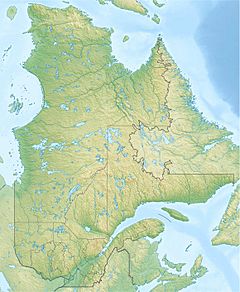Ouelle River facts for kids
Quick facts for kids Ouelle River |
|
|---|---|
| Country | Canada |
| Province | Quebec |
| Region | Chaudière-Appalaches, Bas-Saint-Laurent |
| MRC | L'Islet Regional County Municipality, Kamouraska Regional County Municipality |
| Municipality | Saint-Pacôme, Rivière-Ouelle |
| Physical characteristics | |
| Main source | Mountain stream Tourville 345 metres (1,132 ft) 47°01′55″N 70°06′41″W / 47.03194°N 70.11139°W |
| River mouth | St. Lawrence River Rivière-Ouelle 3 metres (9.8 ft) 47°25′31″N 70°02′50″W / 47.42528°N 70.04722°W |
| Length | 734 kilometres (456 mi) |
| Basin features | |
| Basin size | 860 kilometres (534.38 mi) |
| Tributaries |
|
The Ouelle River (in French: rivière Ouelle) is a river in Quebec, Canada. It flows into the big Saint Lawrence River. This river is important for the areas it passes through. It flows through two main regions in Quebec: Chaudière-Appalaches and Bas-Saint-Laurent.
The Ouelle River flows through towns like Saint-Pacôme and Rivière-Ouelle. It then joins the Saint Lawrence River near Rivière-Ouelle. You can find waterfalls called Chutes de la Riviere Ouelle near Saint-Gabriel-de-Kamouraska.
Scientists believe a big earthquake happened in 1663. Its main starting point was likely along the Saint Lawrence River. This spot was between the mouth of the Malbaie River and the mouth of the Ouelle River.
Contents
Where Does the Ouelle River Start and Go?
The Ouelle River begins in the Notre Dame Mountains. This is east of a place called Rang Terrebonne. The river's source is southwest of the village of Sainte-Perpétue. It is also south of Tourville.
The Ouelle River flows for about 73 kilometres (45 mi). It travels through different areas and changes direction.
The River's Journey: Upper Part
- It flows 1.4 kilometres (0.87 mi) west in Sainte-Perpétue.
- Then it goes 3.2 kilometres (2.0 mi) north. Here, the Charlemagne stream joins it.
- It continues 3.5 kilometres (2.2 mi) northeast. The Gérard-Lévesque stream adds its water here.
- The river flows 2.5 kilometres (1.6 mi) north. This brings it to the border between Sainte-Perpétue and Tourville.
- It travels 3.8 kilometres (2.4 mi) further north. Here, the Bras de la rivière Ouelle joins the river.
The River's Journey: Middle Part
- The river flows 5.6 kilometres (3.5 mi) north.
- It then turns northwest for 1.7 kilometres (1.1 mi). This takes it to the border of Tourville and Saint-Damase-de-L'Islet.
- It flows 16.7 kilometres (10.4 mi) north through a forest. This brings it to the border of Saint-Damase-de-L'Islet and Saint-Onésime-d'Ixworth.
- It goes 1.5 kilometres (0.93 mi) north to a covered bridge.
- The river flows 4.9 kilometres (3.0 mi) north to the Drapeau Sud road bridge.
- It then moves 2.3 kilometres (1.4 mi) northeast. Here, the La Grande Rivière joins it.
The River's Journey: Lower Part
- The river flows 2.2 kilometres (1.4 mi) northeast. It crosses town borders several times.
- It then goes 1.0 kilometre (0.62 mi) north. It forms the border between Saint-Gabriel-Lalemant and Saint-Pacôme.
- It flows 6.6 kilometres (4.1 mi) north in Saint-Gabriel-Lalemant. It winds its way to a road bridge in Saint-Pacôme.
- The river continues 3.1 kilometres (1.9 mi) north to highway bridges.
- It then goes 1.0 kilometre (0.62 mi) northwest to another road bridge.
- The river winds 9.9 kilometres (6.2 mi) west. It passes under a highway bridge.
- Finally, it flows 2.5 kilometres (1.6 mi) west to meet the Saint Lawrence River.
The Ouelle River's end point is about 7.3 kilometres (4.5 mi) west of Saint-Pacôme. It is also 6.4 kilometres (4.0 mi) north of La Pocatière. The river is affected by the tides of the St. Lawrence River for a short distance. You can even canoe on parts of it. The total area that drains into the Ouelle River is 860 kilometres (534.38 mi).
Rivers that Join the Ouelle River
Many smaller rivers and streams flow into the Ouelle River. These are called tributaries. Some of the main ones are:
How the Ouelle River Got Its Name
The name "Ouelle River" has a long history. On an old map from around 1641, it was called "R. Hoel." This name was given to honor Louis Houël. He was an important person who worked for the king. He was also a friend and helper of Samuel de Champlain, a famous explorer. Houël spent a winter in Quebec City in 1640–1641. He also helped bring a group of missionaries, called the Récollets, to New France.
Later, in 1695, a map by Jean Deshayes showed the name as "rivière Ouelle." This is the spelling we use today. The name "rivière Ouelle" was officially recognized on December 5, 1968. This was done by the Commission de toponymie du Québec, which names places in Quebec.


